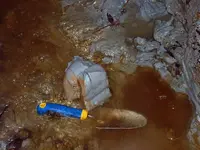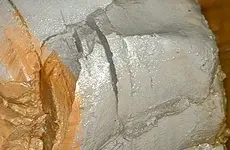Hi Hmmm,
Hmmm, it looks to me that you're in a very iron rich area. I have not followed your posts, and rarely look in here...so don't know what may or may not have been said by others.
Usually iron in one form or another is responsible for coloring clays or soils.
Some examples:
- maghemite will color soils a red or red-brown color, and will have some magnetism to the soil, and that soil may very well compensate about mid-range on a ground balance scale.
- a chemically reduced iron in the ferrous state (Fe+2) will give clays a blue color, whereas an oxidized iron Fe+3 will give clays a red color; these clays are typically weakly magnetic, and ground balance about two-thirds GB range, maybe even approaching the lower magnetite GB compensation range. Of course these clays are not at all magnetic compared to magnetite.
- some limonite (hydrated iron oxides) will cause soils to take on a brownish-yellow color among others. Weakly magnetic, GB compensation roughly two-thirds on a given scale.
In your instance, I suspect your yellow clays are rich in a hydrated ferric oxide named "Lepidocrocite". It is yellow to brown in color and is a known constituent of some yellow clays. It can be quite magnetic at times, but not as magnetic as magnetite. It typically compensates on a GB (ground balance) scale above maghemite on up to about two-thirds of a typical GB scale.
Generally most soils contain several % by weight of iron in one form or another, often mixtures. Most of the iron present within soils is a part of the clay fraction of the soil.[/list]
 any one know about this yellow clay.
any one know about this yellow clay. 
 any one know about this yellow clay.
any one know about this yellow clay. 







